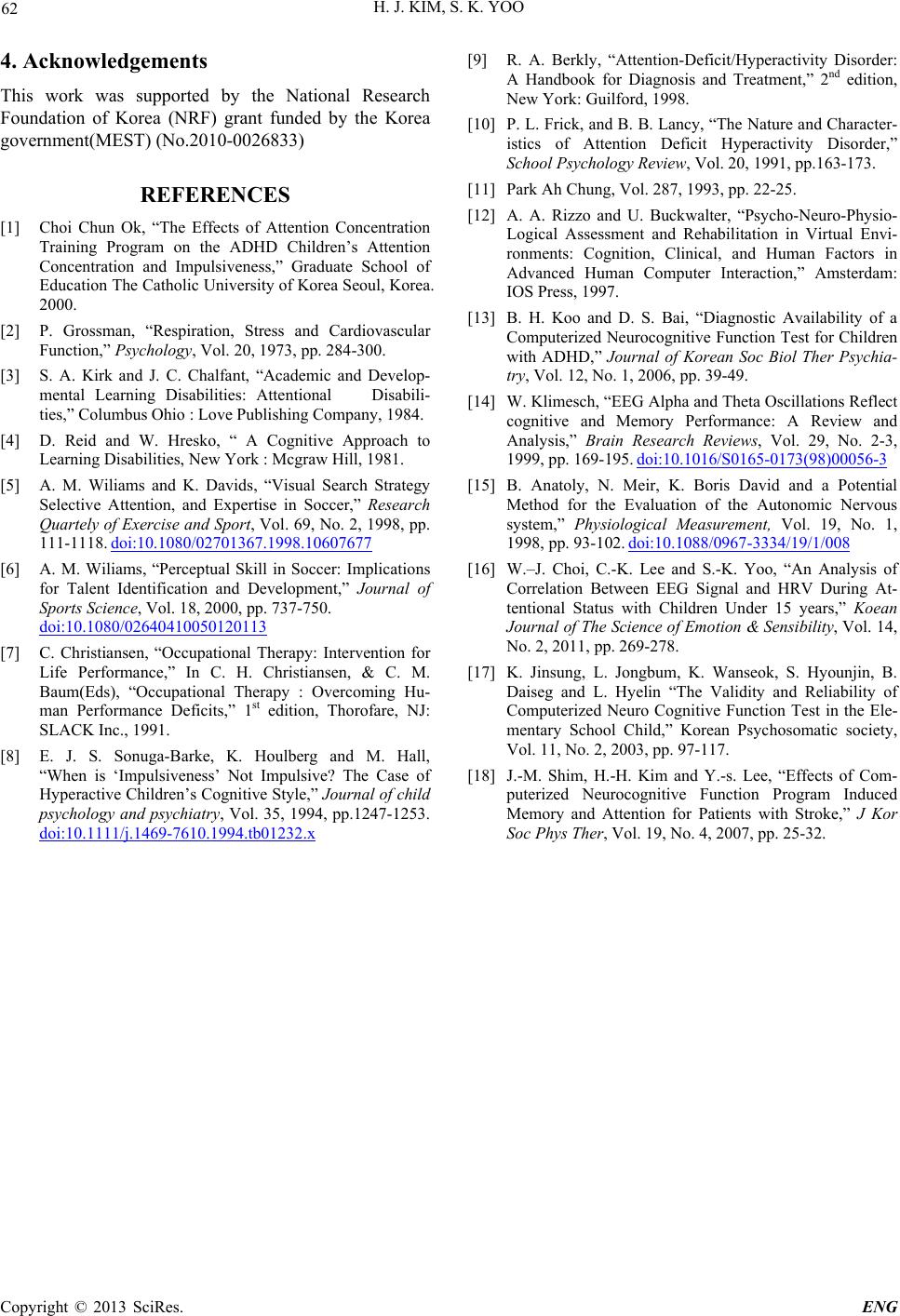
H. J. KIM, S. K. YOO
Copyright © 2013 SciRes. ENG
62
4. Acknowledgements
This work was supported by the National Research
Foundation of Korea (NRF) grant funded by the Korea
government(MEST) (No.2010-0026833)
REFERENCES
[1] Choi Chun Ok, “The Effects of Attention Concentration
Training Program on the ADHD Children’s Attention
Concentration and Impulsiveness,” Graduate School of
Education The Catholic University of Korea Seoul, Korea.
2000.
[2] P. Grossman, “Respiration, Stress and Cardiovascular
Function,” Psychology, Vol. 20, 1973, pp. 284-300.
[3] S. A. Kirk and J. C. Chalfant, “Academic and Develop-
mental Learning Disabilities: Attentional Disabili-
ties,” Columbus Ohio : Love Publishing Company, 1984.
[4] D. Reid and W. Hresko, “ A Cognitive Approach to
Learning Disabilities, New York : Mcgraw Hill, 1981.
[5] A. M. Wiliams and K. Davids, “Visual Search Strategy
Selective Attention, and Expertise in Soccer,” Research
Quartely of Exercise and Sport, Vol. 69, No. 2, 1998, pp.
111-1118. doi:10.1080/02701367.1998.10607677
[6] A. M. Wiliams, “Perceptual Skill in Soccer: Implications
for Talent Identification and Development,” Journal of
Sports Science, Vol. 18, 2000, pp. 737-750.
doi:10.1080/02640410050120113
[7] C. Christiansen, “Occupational Therapy: Intervention for
Life Performance,” In C. H. Christiansen, & C. M.
Baum(Eds), “Occupational Therapy : Overcoming Hu-
man Performance Deficits,” 1st edition, Thorofare, NJ:
SLACK Inc., 1991.
[8] E. J. S. Sonuga-Barke, K. Houlberg and M. Hall,
“When is ‘Impulsiveness’ Not Impulsive? The Case of
Hyperactive Children’s Cognitive Style,” Journal of child
psychology and psychiatry, Vol. 35, 1994, pp.1247-1253.
doi:10.1111/j.1469-7610.1994.tb01232.x
[9] R. A. Berkly, “Attention-Deficit/Hyperactivity Disorder:
A Handbook for Diagnosis and Treatment,” 2nd edition,
New York: Guilford, 1998.
[10] P. L. Frick, and B. B. Lancy, “The Nature and Character-
istics of Attention Deficit Hyperactivity Disorder,”
School Psychology Review, Vol. 20, 1991, pp.163-173.
[11] Park Ah Chung, Vol. 287, 1993, pp. 22-25.
[12] A. A. Rizzo and U. Buckwalter, “Psycho-Neuro-Physio-
Logical Assessment and Rehabilitation in Virtual Envi-
ronments: Cognition, Clinical, and Human Factors in
Advanced Human Computer Interaction,” Amsterdam:
IOS Press, 1997.
[13] B. H. Koo and D. S. Bai, “Diagnostic Availability of a
Computerized Neurocognitive Function Test for Children
with ADHD,” Journal of Korean Soc Biol Ther Psychia-
try, Vol. 12, No. 1, 2006, pp. 39-49.
[14] W. Klimesch, “EEG Alpha and Theta Oscillations Reflect
cognitive and Memory Performance: A Review and
Analysis,” Brain Research Reviews, Vol. 29, No. 2-3,
1999, pp. 169-195. doi:10.1016/S0165-0173(98)00056-3
[15] B. Anatoly, N. Meir, K. Boris David and a Potential
Method for the Evaluation of the Autonomic Nervous
system,” Physiological Measurement, Vol. 19, No. 1,
1998, pp. 93-102. doi:10.1088/0967-3334/19/1/008
[16] W.–J. Choi, C.-K. Lee and S.-K. Yoo, “An Analysis of
Correlation Between EEG Signal and HRV During At-
tentional Status with Children Under 15 years,” Koean
Journal of The Science of Emotion & Sensibility, Vol. 14,
No. 2, 2011, pp. 269-278.
[17] K. Jinsung, L. Jongbum, K. Wanseok, S. Hyounjin, B.
Daiseg and L. Hyelin “The Validity and Reliability of
Computerized Neuro Cognitive Function Test in the Ele-
mentary School Child,” Korean Psychosomatic society,
Vol. 11, No. 2, 2003, pp. 97-117.
[18] J.-M. Shim, H.-H. Kim and Y.-s. Lee, “Effects of Com-
puterized Neurocognitive Function Program Induced
Memory and Attention for Patients with Stroke,” J Kor
Soc Phys Ther, Vol. 19, No. 4, 2007, pp. 25-32.